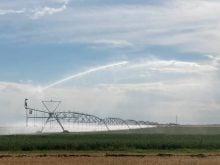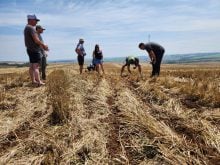The Westside irrigation expansion in Saskatchewan, a $4 billion plan, remains that, a plan.
The Saskatchewan Water Security Agency is doing the groundwork before any earth moving begins.
Environmental assessments of the soils’ appropriateness for irrigation and surveys of the planned routes are underway, said Clinton Molde during Saskatoon’s Crop Production Show earlier this month.
Producers attending the update on the project posed questions for the organization’s leader about when the water would begin to flow, now that a plan to continue with the stalled expansion has been endorsed by the provincial and federal governments.
Read Also

U.S. softens fees on Chinese shipping
The U.S. starts charging new fees on Chinese ships on Oct. 14. What are the ramifications for their ag exports?
As part of a national infrastructure development program shared with the provinces, Saskatchewan’s irrigation project is expected to provide job opportunities and help to “drought-proof” the province’s agricultural and food processing sectors.
The expansion of the system stopped in 1973 with 42 of the 45 kilometres of the current main canal dug, 19 kilometres is lightly used today by a group of local producers.
Those growers have installed their own pumps and treat their portion of the canal like a large dugout. That portion of the system would be the first step of construction because it needs rehabilitation and modernization for the large water flows envisioned in the project.
The plan for the system on the west side of the South Saskatchewan River, augmenting the work completed in the 1960s on the eastern side, would see irrigation grow from 3,000 acres to 340,000. In all, 400 km of new canals will be needed to reach that potential size for the project.
So far, this past year, 40,000 acres of fields have been soil sampled and another three to four years will be required to finish planning and environmental assessments, said the SWSA’s executive director.
“It will take about 10 years to build, 20 to 30 years until it is fully operational and all the benefits are being derived,” said Molde.
While the Westside project is being planned, a future 120,000 irrigated acres near Moose Jaw aren’t on the drawing board yet, he said.
That piece of the drought prevention puzzle has yet to be placed. Known as the Qu’Appelle South sector, it forms the remaining phase of project.
Including the current 110,000 acres irrigated from Lake Diefenbaker, the full proposed expansion would push Saskatchewan’s irrigated land from the South Saskatchewan system to 455,000 acres.

















